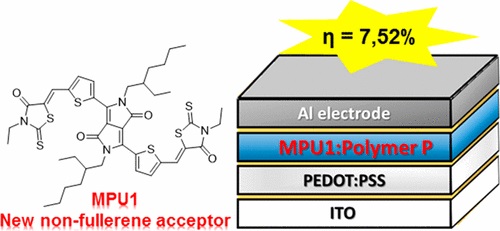
In this research line push-pull molecules are synthetized to be used as p-type semiconductors, which, in combination with n-type semiconductors, are used for the construction of organic solar cells. The work in this line is divided in two tasks. The first is the construction of push-pull molecules with application as p-type semiconductors in the so called small molecule bulk heterojunction solar cells (SMBHJ). In this task Donor-Acceptor-Donor and Acceptor-Donor-Acceptor ensembles are synthetized using known electron rich molecules as donors porphyrins (scarcely considered in this field), dicyanovinylene or rhodanine groups as electron acceptors and the corresponding oligomers acting as spacers or, in some cases, as secondary electron donors. The aim of this task is design an synthetize push-pull molecules that, when they are incorporated in SMBHJ solar cells, lead to higher Fill factors and Photocurrent without changing the open circuit voltage. The second task is the construction of push-pull dyes for Dye sensitized solar cells (DSSC) based on the structure Donor-Spacer-Acceptors or Donor-Acceptor1-Acceptor2. The aim of this part of the research is the develop dyes with good light harvesting ability and good conduction of charge through them. The molecules that are used as donors are porphyrins and conjugated oligomers and the electron acceptor is cyanoacrilic acid moiety. In both task, after full characterization of the electronic properties of the dyes, with the molecules that show the more interesting properties, devices are constructed in collaboration with other research groups in the field.
Latest publications of the group in the field:
- Highly efficient (15.09%) ternary solar cells constructed with a porphyrin as donor and two acceptors. ACS Applied Energy Materials, 2021.
- Reducing energy loss in organic solar cells by changing the central metal in metalloporphyrins. ChemSusChem, 2021
- Effect of the dipole moment in a non-fullerene small molecule acceptor on the efficiency of polymer solar cells. Solar Energy,2021.
- Ternary all small molecule solar cell with two small molecule donors and Y6 non-fullerene acceptor with a power conversion efficiency over above 14% processed from a non-halogenated solvent. Solar RRL, 4,1900471
- The influence of the terminal acceptor and oligomer length on the photovoltaic properties of A-D-A small molecule donors. Journal of Materials Chemistry C, 2020, 8, 4763 - 4770.
- Panchromatic Triple Organic Semiconductor Heterojunctions for Efficient Solar Cells. ACS Applied Energy Materials, 2020, 3, 12
- Ternary Organic Solar Cell with a Near-Infrared Absorbing Selenophene-Diketopyrrolopyrrole-Based Nonfullerene Acceptor and an Efficiency above 10%. Solar RRL, 2020, 1900471.